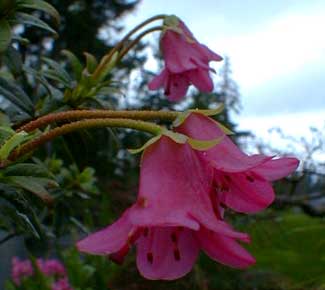
Rhododendron campylogynum
(Cremestrum Group) 'Bodnant Red'
"She rides a red leopard -
striped lynxes following behind -
Her chariot of magnolia
arrayed with banners of cassia,
Her cloak made of orchids
and her girdle of azalea,
Calling sweet flowers
for those dear in her heart."
-The Mountain Spirit
by Qu Yuan
(40 BC-27 8BC)
by Qu Yuan
(40 BC-27 8BC)
Rhododendron campylogynum is a wild azalea that grows native in Burma, Yunnan Provence, Tibet, & Arunachal Pradesh in India, with a preference for moist rocky thicket margins or mossy moorlands.
As is often the case with such widespread shrubs, the species can be quite varied in habit, ranging from nearly prostrate to strongly upright, or anything in between. Prostrate to mounding are the most common; but the specimen I photographed in a friend's garden is strongly upright.
In my own garden I have a different R. campylogynum of the Cremestrum Group which has smaller thimble-flowers & not so strongly upright. But the specimen shown on this page is specifically the named variety 'Bodnant Red,' a notably upright clone developed by Peter Cox of Scotland. His clone received the Award of Garden Merit in 1971.
'Bodnant Red' flowers in late March & April, though others report it blooming May & into June. The species can vary in color, from rose to pale pink to yellow. 'Bodnant Red' has dark red blooms that look like dangling thimble-sized bells, occuring in groups of one, two, or three.
Dwarf lepidote species-rhodies with red flowers are uncommon, so both in form & color, this shrub is very distinct compared to the usual trusses of trumpet-flowers on most rhododendrons, as well as the usual shades of violet-purple-lavender on so many dwarf lepidotes.
'Bodnant Red' is cold-hardy to minus 15 degrees F. & flowers best in bright shade. The species tends to reach only about two feet in ten years, but it can be larger for 'Bodnant Red' due to its strongly upright stance.
The species has a broader pH tolerance than most rhodies, from acidic to moderately alkaline, & might be a good choice in regions with limey soils where most rhodies won't thrive.